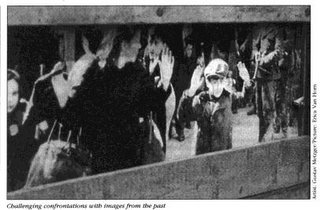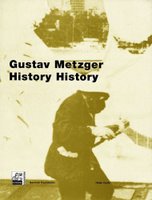Art Strike 1977-1980 and other auto-destructive activities

Gustav Metzger
Auto-destructive art is primarily a form of public art for industrial societies.
Self-destructive painting, sculpture and construction is a total unity of idea, site, form, colour, method, and timing of the disintegrative process.
Auto-destructive art can be created with natural forces, traditional art techniques and technological techniques.
The amplified sound of the auto-destructive process can be an element of the total conception.
The artist may collaborate with scientists, engineers.
Self-destructive art can be machine produced and factory assembled.
Auto-destructive paintings, sculptures and constructions have a life time varying from a few moments to twenty years. When the disintegrative process is complete the work is to be removed from the site and scrapped.
Gustav Metzger - Auto-Destructive Art 4 November 1959
-------------------------------
Man In Regent Street is auto-destructive.
Rockets, nuclear weapons, are auto-destructive.
Auto-destructive art.
The drop drop dropping of HH bombs.
Not interested in ruins, (the picturesque)
Auto-destructive art re-enacts the obsession with destruction, the pummeling to which individuals and masses are subjected.Auto-destructive art mirrors the compulsive perfectionism of arms manufacture - polishing to destruction point.
Auto-destructive art is the transformation of technology into public art. The immense productive capacity, the chaos of capitalism and of Soviet communism, the co-existence of surplus and starvation; the increasing stock-piling of nuclear weapons - more than enough to destroy technological societies; the disintegrative effect of machinery and of life in vast built-up areas on the person,...
Auto-destructive art is art which contains within itself an agent which automatically leads to its destruction within a period of time not to exceed twenty years. Other forms of auto-destructive art involve manual manipulation. There are forms of auto-destructive art where the artist has a tight control over the nature and timing of the disintegrative process, and there are other forms where the artist's control is slight.
Materials and techniques used in creating auto-destructive art include: Acid, Adhesives, Ballistics, Canvas, Clay, Combustion, Compression, Concrete, Corrosion, Cybernetics, Drop, Elasticity, Electricity, Electrolysis, Feed-Back, Glass, Heat, Human Energy, Ice, Jet, Light, Load, Mass-production, Metal, Motion Picture, Natural Forces, Nuclear Energy, Paint, Paper, Photography, Plaster, Plastics, Pressure, Radiation, Sand, Solar Energy, Sound, Steam, Stress, Terra-cotta, Vibration, Water, Welding, Wire, Wood.
Gustav Metzger - Manifesto Auto-Destructive Art (10 March 1960)
-------------------------------
Each visible fact absolutely expresses its reality.
Certain machine produced forms are the most perfect forms of our period.
In the evenings some of the finest works of art produced now are dumped on the streets of Soho.
Auto creative art is art of change, growth movement.
Auto-destructive art and auto creative art aim at the integration of art with the advances of science and technology. The immediate objective is the creation, with the aid of computers, of works of art whose movements are programmed and include "self-regulation". The spectator, by means of electronic devices can have a direct bearing on the action of these works.
Auto-destructive art is an attack on capitalist values and the drive to nuclear annihilation.
Gustav Metzger - Auto Destructive Art Machine Auto Creative Art (23 June 1961)
-------------------------------
An artist who painted hydrochloric acid onto a canvas so that eventually the painting was entirely eaten away, as 'an attack on art dealers and collectors who manipulate modern art for profit', was never going to climb the art world career ladder. Gustav Metzger's invisibility to all but a small circle is the consequence of his lifelong commitment to politically confrontational art and scorn for the showcase of the commercial gallery.
His family perished in the Holocaust, and his early experiences fuelled his political ideas and enduring opposition to the barbarity and destruction of the capitalist system. Metzger's CND activities have put him in jail and his subversive art events have resulted in prosecution.
His career might best be descibed in three sections: 'Auto-Creative Art', 'Auto-Destructive Art' (expressions of the potential for creativity and the drive to destruction in the 20th century) as well as his latter-day body of work begun in his seventies known as 'Historic Photographs'. These are a series of installations which powerfully engage the spectator in a physical and psychic relation to press images of momentous or tragic events from the last 50 years of history.
In the first set are examples of 'Auto-Creative Art' - mesmerisingly beautiful liquid crystal light projections first made in the 1960s. The middle section comprises the models and documents of 'Auto-Destructive Art' in which Metzger developed an 'aesthetic of revulsion', where self-destruction was built in to the art as a mirror of a system careering towards annihilation.
-------

In honor of the publication of Metzger: History on History

0 Comments:
Post a Comment
<< Home